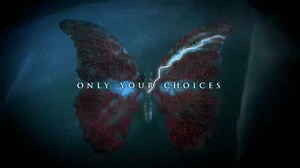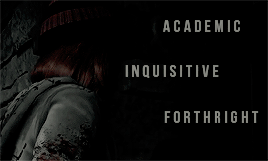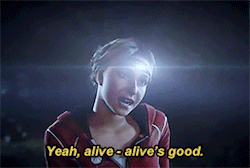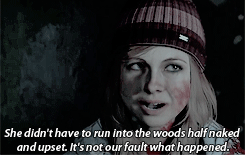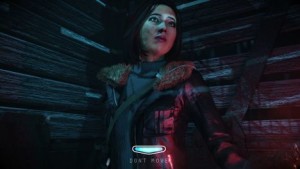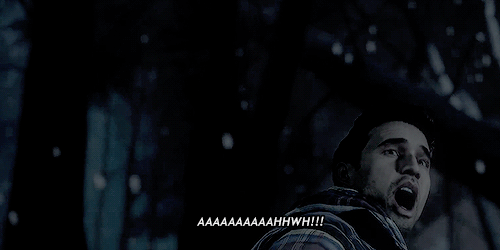For as long as I can remember, I’ve been a fan of the “Horror” movie genre. I grew up in a time when the sub-category of “Slasher” films were the norm – a genre that created my favorite horror movie series in Wes Craven’s “A Nightmare of Elm Street”. But when it came to horror/survival horror video games, I was less than enthralled – though I did enjoy the first four “Resident Evil” games (all for different reasons) and “Silent Hill 2” proved to be one of the greatest feats in creating true suspense and terror – becoming a personal benchmark for years. My time with Survival Horror genre dwindled, leaving me in the land of the undead only during sessions of Telltale Games’ adaptation of “The Walking Dead”, the co-op first-person shooter that is “Left 4 Dead”, Xbox’s exclusive fort-building, zed-slaying adventure “State of Decay”, and the playable teaser that would’ve created the next “Silent Hill” game, “P.T.”.
Not long after “P.T.’s” release, videos of an upcoming Playstation 4 exclusive was shown featuring several people stuck in a cabin, fighting for survival against an unknown force. This game was being promoted as a slasher film turned into a video game where the player had the opportunity to choose who lives or dies through their actions. I was immediately intrigued and waited until the game’s release to see if the supposed choices presented did matter and, most importantly, if it captured the essence of the genre it was inspired by while delivering a video game worth playing again, and again, and again (and maybe again).
Did I Complete “Until Dawn”
Developed by SuperMassive Games as a “Playstation Move”-oriented piece of software for the Playstation 3, “Until Dawn” quietly ditched its original home console and moved onto the Playstation 4 as an exclusive for the system that would be unlike anything seen thus far. Gamers have the ability to control eight different characters during various sequences as they return to the site of a tragic accident that occurred one-year prior. It doesn’t take long before a majority of the game’s mechanics is introduced from character movement, to object interaction, to shooting, to making story-defining choices. The latter gameplay design is where “Until Dawn” asks you to spend most of your brain power on as it ties into everything including the in-game system dubbed “The Butterfly Effect” (yep, the phenomenon that inspired a movie starring Ashton Kutcher).
“The Butterfly Effect” tracks the choices that change the overall story and determines who lives or dies. This adds a sense of replayability, as the gamer will probably question the decisions made during certain scenes. In an effort to see how well my decision making would help a group of friends survive such a horrific scenario, my initial playthrough saw me go in cold (no pun intended) – no tips, guides or walkthroughs that would help me make the best decisions and understand what to do and where to go during certain situations. Remembering what I did the first go-round, my second playthrough focused on trophies where I gathered every item possible, made all the right choices and watched the finale where everyone lived. I did half of a playthrough to clean up trophies and witness what would happen if everyone died. By the time the final trophy popped (around twenty hours), I had witnessed all the meaningful moments this game had to offer (including the incredible credit reel).
Did “Until Dawn” Live Up to the Hype?
As mentioned several times above, “Until Dawn” focuses its gameplay around the basis of choice. Taking a page out of the works of Quantic Dream’s “Fahrenheit”, “Heavy Rain” & “Beyond: Two Souls”, and the Telltale Games various TV and movie adaptations, actual and stereotypical gameplay is minimal. The player has the ability to move a character around, interact with certain objects and people with the touch of a button and stare at the pause screen featuring the faces of whoever is being utilized to advance the story (and the sheer terror that envelops them as the game progresses). Like the aforementioned games, SuperMassive’s entry in the growing genre of “Quick Time Event” (or “QTE”) based games features very little “physical” activity when utilizing a character. Instead, the player is forced to unravel the mystery behind the budding story and, in the case of “Until Dawn”, have a group of characters survive … until dawn! Thankfully, the QTEs are responsive and do a great job rewarding or punishing you for either messing up or not paying attention (something I had trouble with at times when I’m thinking a dialogue sequence is just that and is only there for exposition purposes).
The choices presented in the game range from obvious and straightforward to confusing and vague. There are moments such as opting to high five a character that appears trivial, but the reaction will make anyone question whether or not performing the action actually means something in the grander scheme. Thankfully, “Until Dawn” goes out of its way to inform the player when something important occurs. Depending on the decision made during a particular choice, a butterfly symbol will flash in the corner of the screen (spawning a slew of fluttering creatures for further emphasis). Added to the provided signaling is a section in the pause screen menu that recaps the major decisions and consequences. This becomes very helpful for future playthroughs that can reach upwards of eight hours depending on how many people you can keep alive for the game’s majority.
That’s not to state minor decisions don’t mean anything to the story. Depending on certain choices, character interactions change and actually affect the ways the group works together and, in most cases, live or die together. There are also moments presented where the best option is to do nothing – a choice that is rarely seen in games like “Until Dawn”. Another mechanic to help the player make the right choices are collectable items called “totems” that showcase visions of the potential future ranging from slight dangers to actual deaths. Depending on the way a player crafts the story through his/her choices, some of these visions are incredibly helpful. There are other collectibles in the game that expand the world and story presented. The lore of “Until Dawn” on the surface seems like a simple homage to the horror genre, but actually creates a universe that would make for a great prequel-sequel or even an actual successor in the timeline.
Though “Until Dawn” is essentially a port from the PS3 to the PS4, SuperMassive did an incredible job of transforming the look of their project into a true eighth generation experience. Beyond the lifelike rendering of actors such as Hayden Panettiere, Brett Dalton and Rami Malek are the snow-covered mountain, dank caves and, of course, an obscenely large cabin with electrical problems that are well detailed and perfectly capture the essence of what the game is all about. The characters greatly add to the immersion necessary for a game like this to work. They are prototypical to the genre right down to the descriptions of each character during their respective introductions.
You have the awkward guy who makes terrible jokes in Chris. There’s Mike and Jessica, the horny couple who will put themselves in the middle of nowhere during a snowstorm just to get busy. And, of course, there’s the overall strong protagonist that every girl wants to be and every guy wants to get with that Panettiere plays, “Sam”. Though they don’t always feel natural, they are perfect for a horror movie-esque game and pick at you in all the right ways while the player makes long-term decisions that will keep them alive or not-so-alive.
But there are some problems with “Until Dawn”. Being presented as horror movie characters stuck in a video game, the leads ask some of the stupidest questions, do some of the stupidest things and willingly put themselves in positions of danger even when they know they shouldn’t. It can become annoying when you’re in the middle of a situation and wished you had more freedom in an effort to survive. Obviously this affects the plot. With the promise of “choice” being the glue that holds this entire game together, the story is incredibly linear. Yes, some people will die at different times because of the decisions you make, but the game insures that a player sees the very end no matter what is done. After two playthroughs it became painfully obvious that two particular characters are protected from death for the simple reason SuperMassive Games wants you to see what they’ve created mostly in full.
Unfortunately what is “full” can be seen as disappointing for some. The game’s first half is marvelously constructed – harkening to the days when slasher films were the go-to sub-genre for horror movies. Then there’s a plot twist that changes the story’s entire dynamic. This creates a feeling that SuperMassive Games had an idea for two separate games, realized they couldn’t make a pair of stories long enough to warrant production and decided to splice them together – leaving plot holes and unexplainable circumstances aplenty by the game’s end no matter if do everything right and collect all the items.
Also there are times when the choices themselves result in the same outcome. One incredibly important decision that is made during the game’s prologue has the same result no matter what choice you pick because both options are practically the same. There are several moments like these in the game that makes everything feel less free than it should. SuperMassive Games definitely didn’t learn from the game’s spiritual predecessors by not adding a “dialogue skip” option. During my second playthrough I wanted to hasten my experience as I had already seen or heard certain sections, but found no ability to do so. Players will be stuck listening to the same conversations in full no matter what.
There are also quite a few mechanical issues. Walking feels stiff and robotic, causing characters to move in awkward directions in the slowest ways possible. Even the “Walk faster” button doesn’t do much to alleviate this problem as I struggled at times to recognize if I was actually pressing the button. The fixed camera can prove to be a problem at times, stopping and shifting suddenly when a player is nearing a corner or an entrance/exit, or simple by moving forward. Though the characters are motion captured, facial animations can struggle at times; causing frustrated expressions, for example, to seem wooden and laughable. One of the game’s biggest technical mistakes is a lack of inverted axis option. For gamers like myself, this isn’t a problem. For others, it can prove to be detrimental. And then there’s the “Don’t Move” command. Several moments in the game features a demand for the player to hold his/her controller completely still. Usually these commands come out of nowhere and can even follow a “jump scare” moment that makes heeding the instruction quite problematic. Turning off the Dualshock 4’s vibration helps, but doesn’t stop it from being a flawed addition to an otherwise solid control scheme.
Several moments in the game feature a demand for the player to hold his/her controller completely still. Usually these commands come out of nowhere and can even follow a “jump scare” moment that makes heeding the instruction quite problematic. Turning off the Dualshock 4’s vibration helps, but doesn’t stop it from being a flawed addition to an otherwise solid control scheme.
It’s sad that a few problems with the core mechanics can hinder a game with so much atmosphere, perfectly crafted and acted characters for the genre, and choices that mostly matter to the overall plot from reaching the greatness it had all the makings of attaining.
Should You Play “Until Dawn”?
Though “Until Dawn” has some issues technically, it still made for an enjoyable experience because it was exactly what it promised to be – a fully interactive slasher movie where the choices made could or could not change the overall story. For gamers who enjoy the creations of Quantic Dream and Telltale Games and/or appreciate the simplicity of the slasher movie genre will get a kick out of “Until Dawn” during at least two playthroughs. But witnessing the same scenes and hearing the same conversations without the ability to skip just to see what would happen if you decided to have the token African American stand up for himself when his girlfriend tries to verbally emasculate him in front of everyone can prove tedious. “Until Dawn” is definitely worthy of playing if you know what you’re getting yourself into. Heck, it’ll probably even surprise you in a good way like someone placing a spring-loaded skull mask inside of an abandoned truck to potentially scare someone who might just be wandering around the woods on a random, snowy night. Just make sure you play “Until Dawn” without a full bladder.


